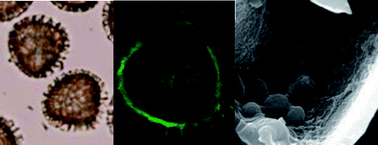Encapsulation of living cells into sporopollenin microcapsules
Abstract
We demonstrate that living cells can be encapsulated inside sporopollenin microcapsules derived from Lycopodium clavatum. To encapsulate large objects like cells, the sporopollenin particles are compressed into a pellet which forces their trilite scars to open up. Our method involves exposing a sporopollenin pellet to an aqueous suspension of cells in the presence of a surface active agent which facilitates the capillary suction of the cells suspension inside the compressed sporopollenin and its “re-inflating” and closure of trilite scars. We demonstrate that the viability of the cells is preserved after the encapsulation in the sporopollenin capsules which contain a significant amount of entrapped cells and show biological activity when placed into a culture medium. Since the sporopollenin nanopores allow


 Please wait while we load your content...
Please wait while we load your content...